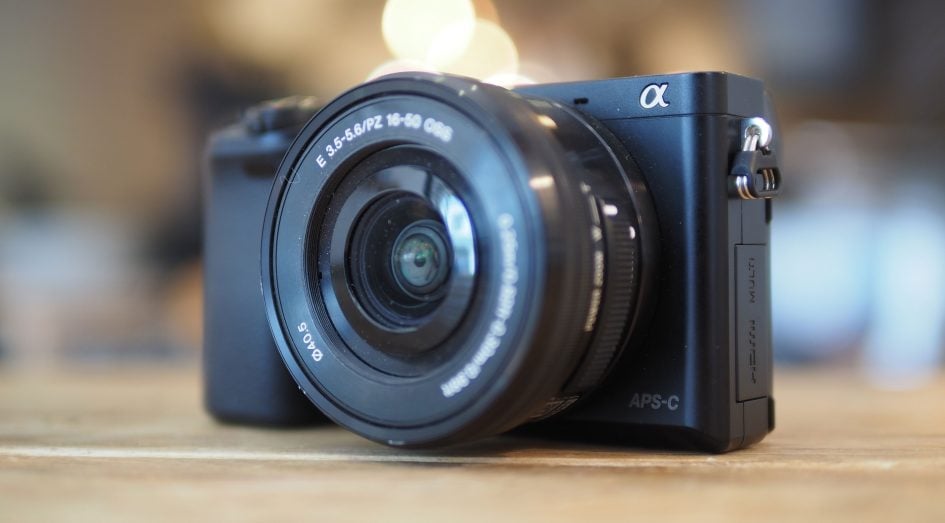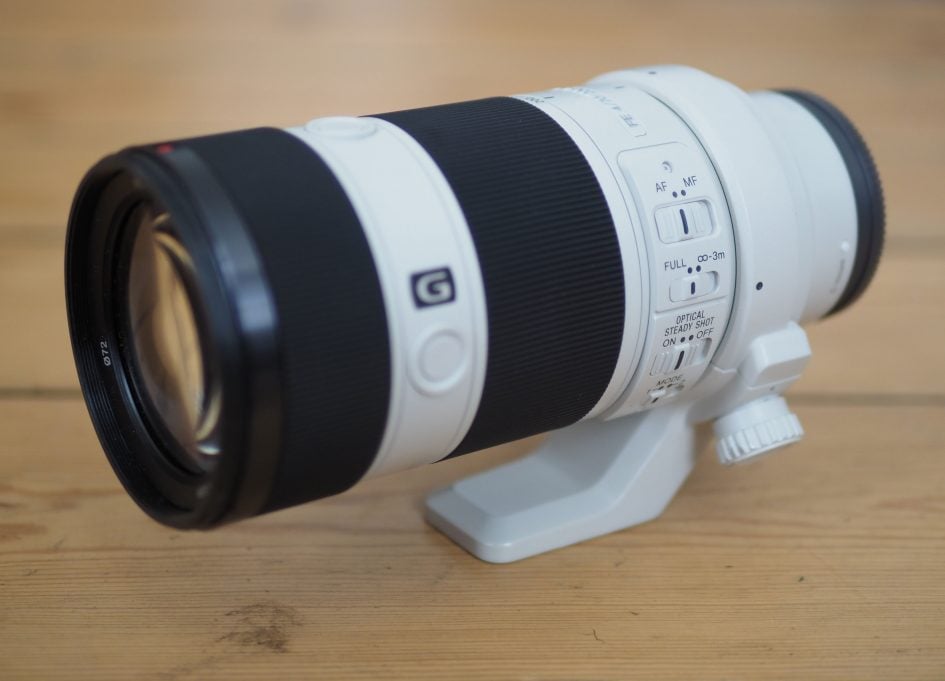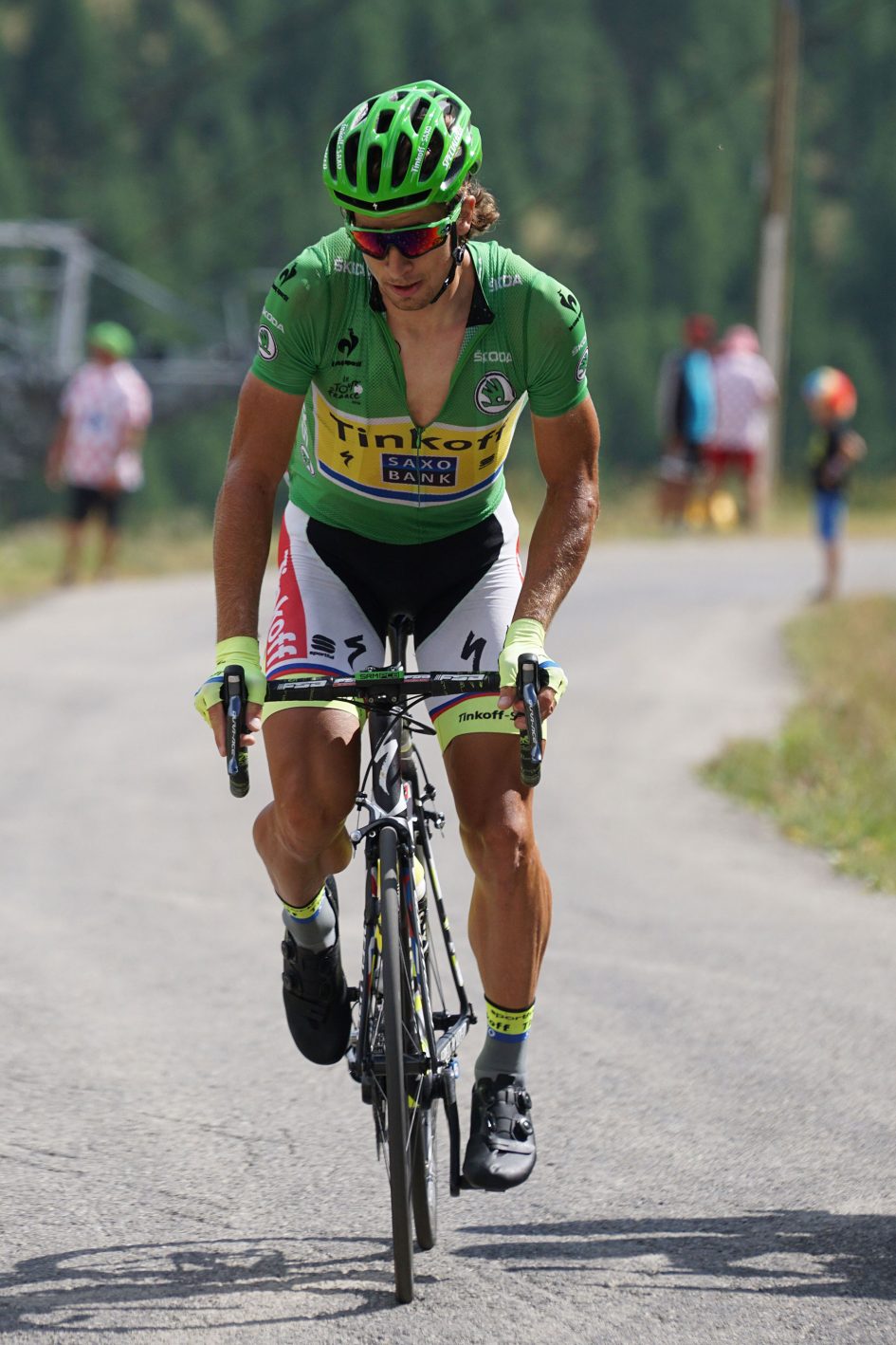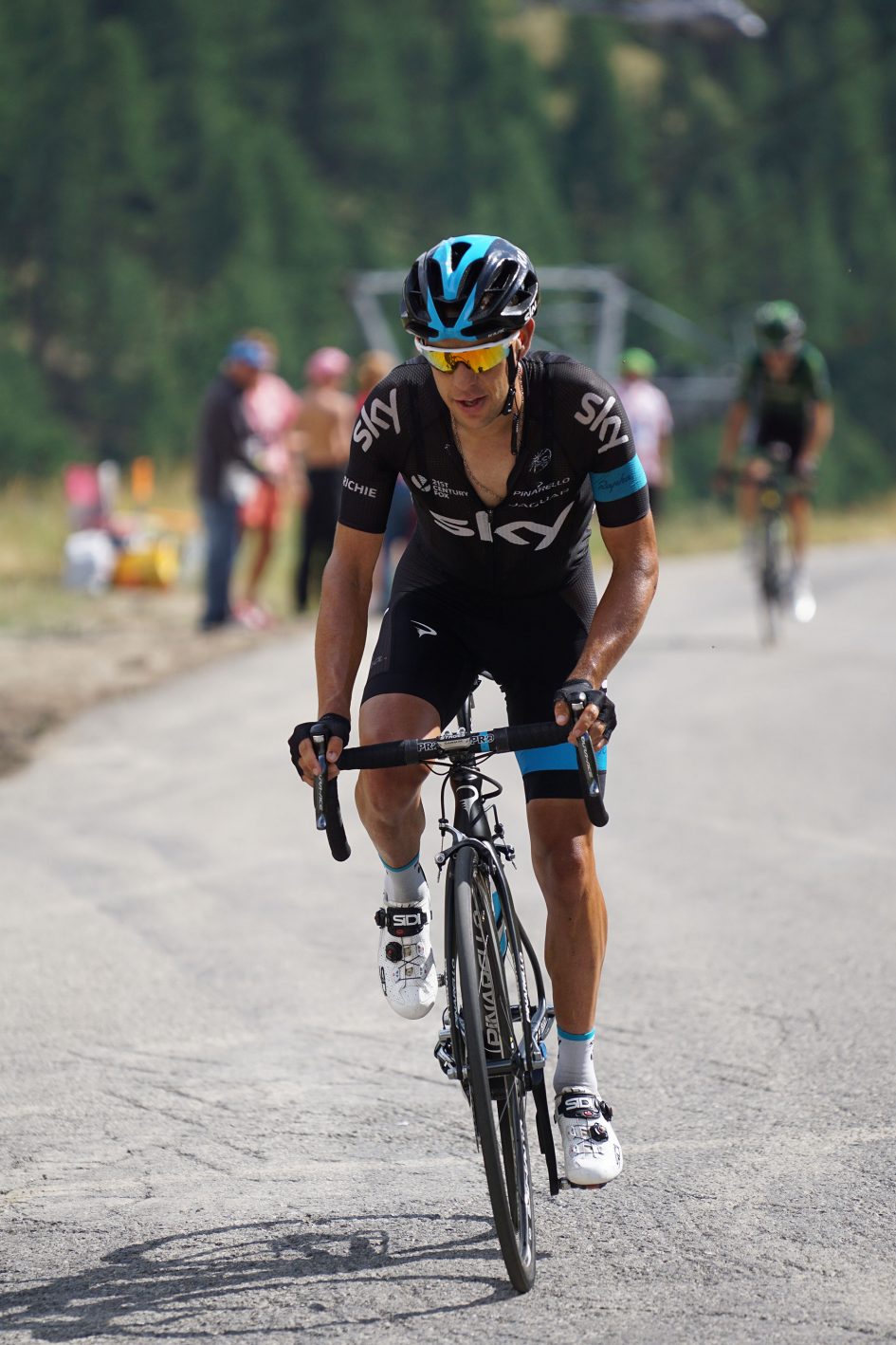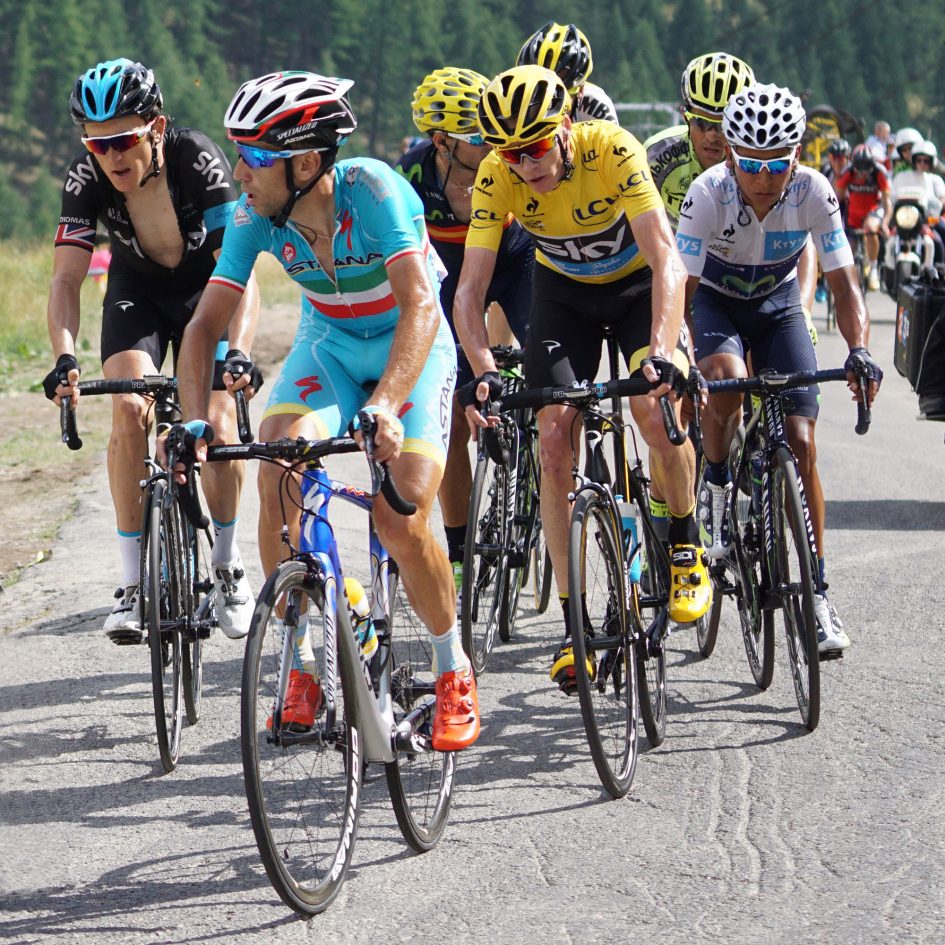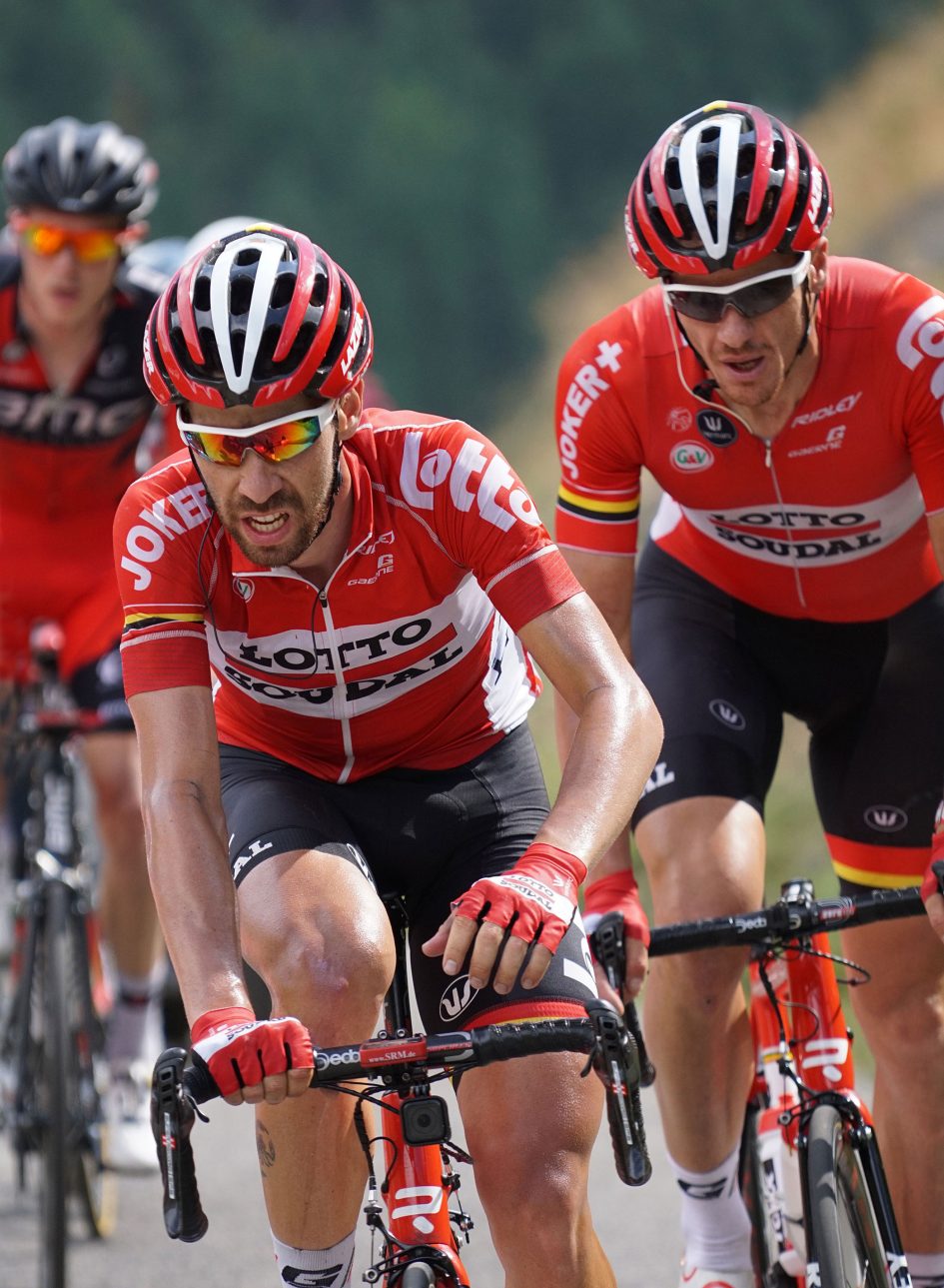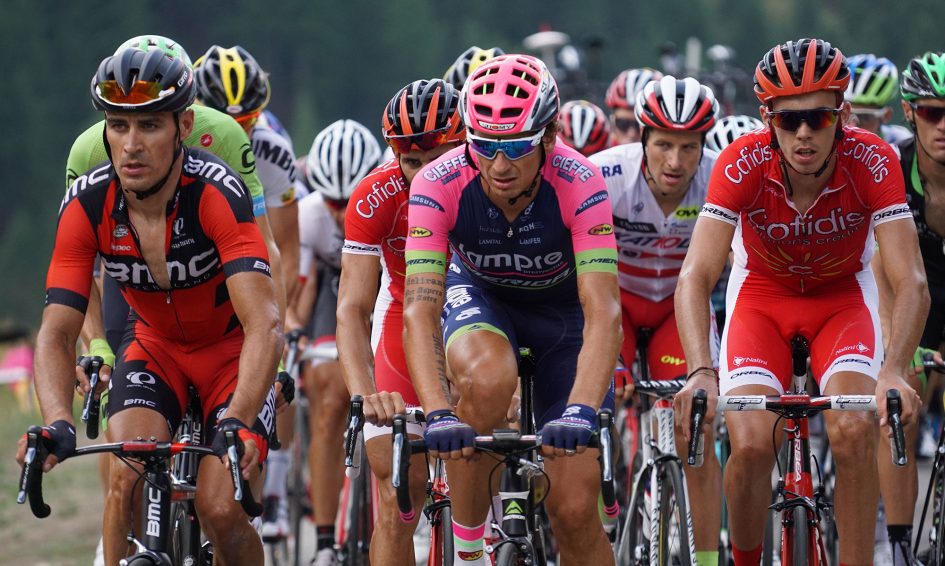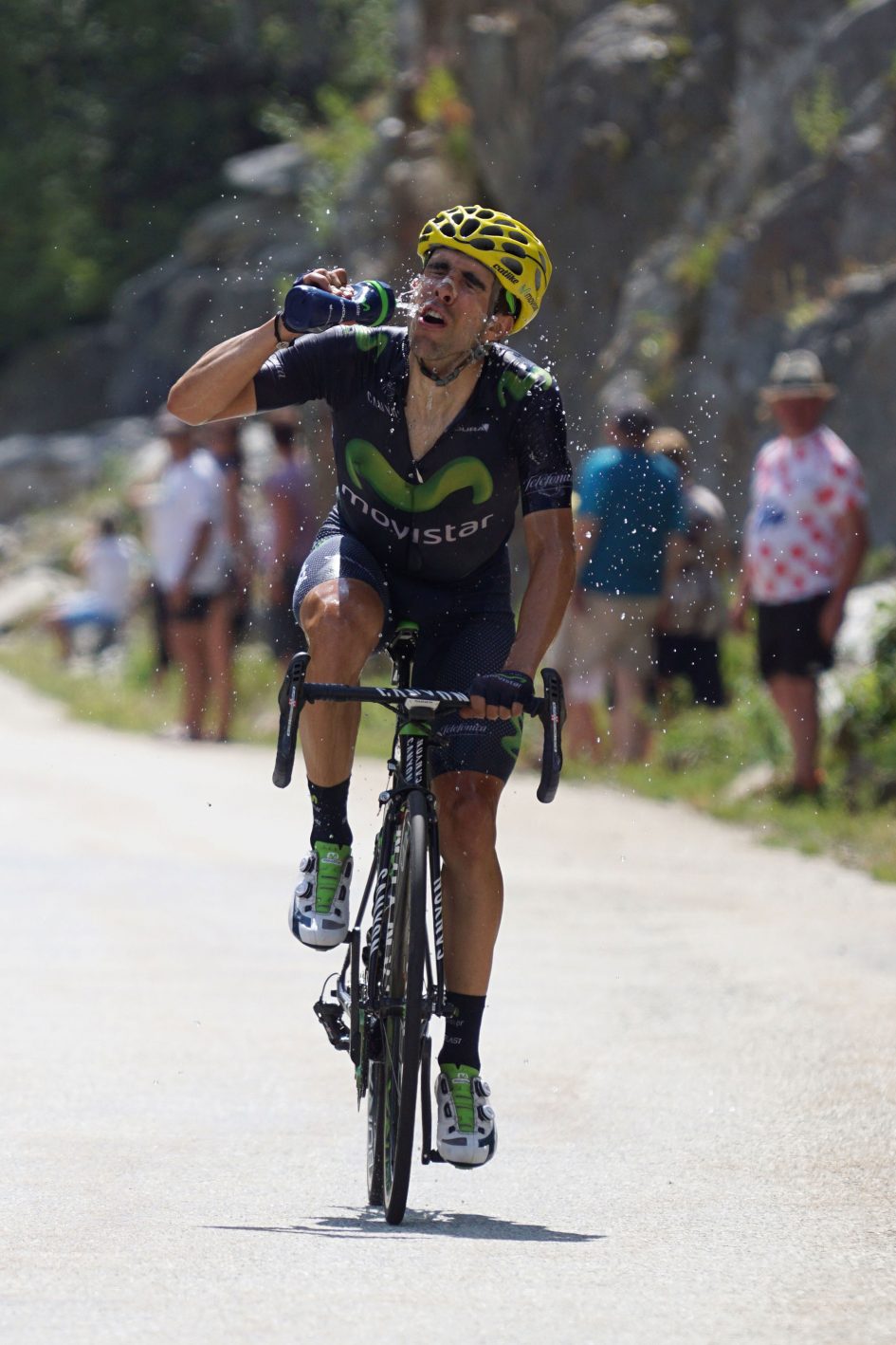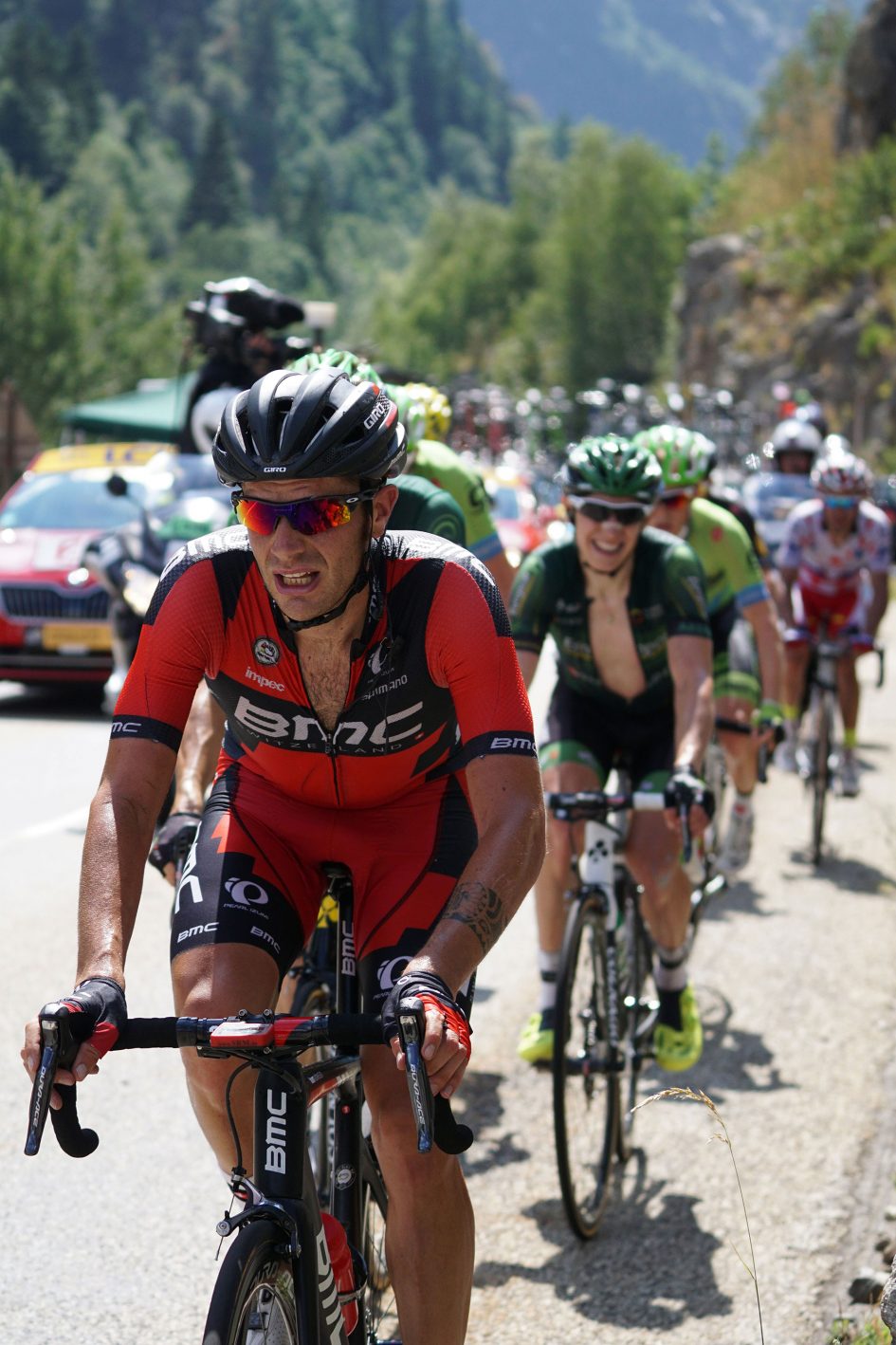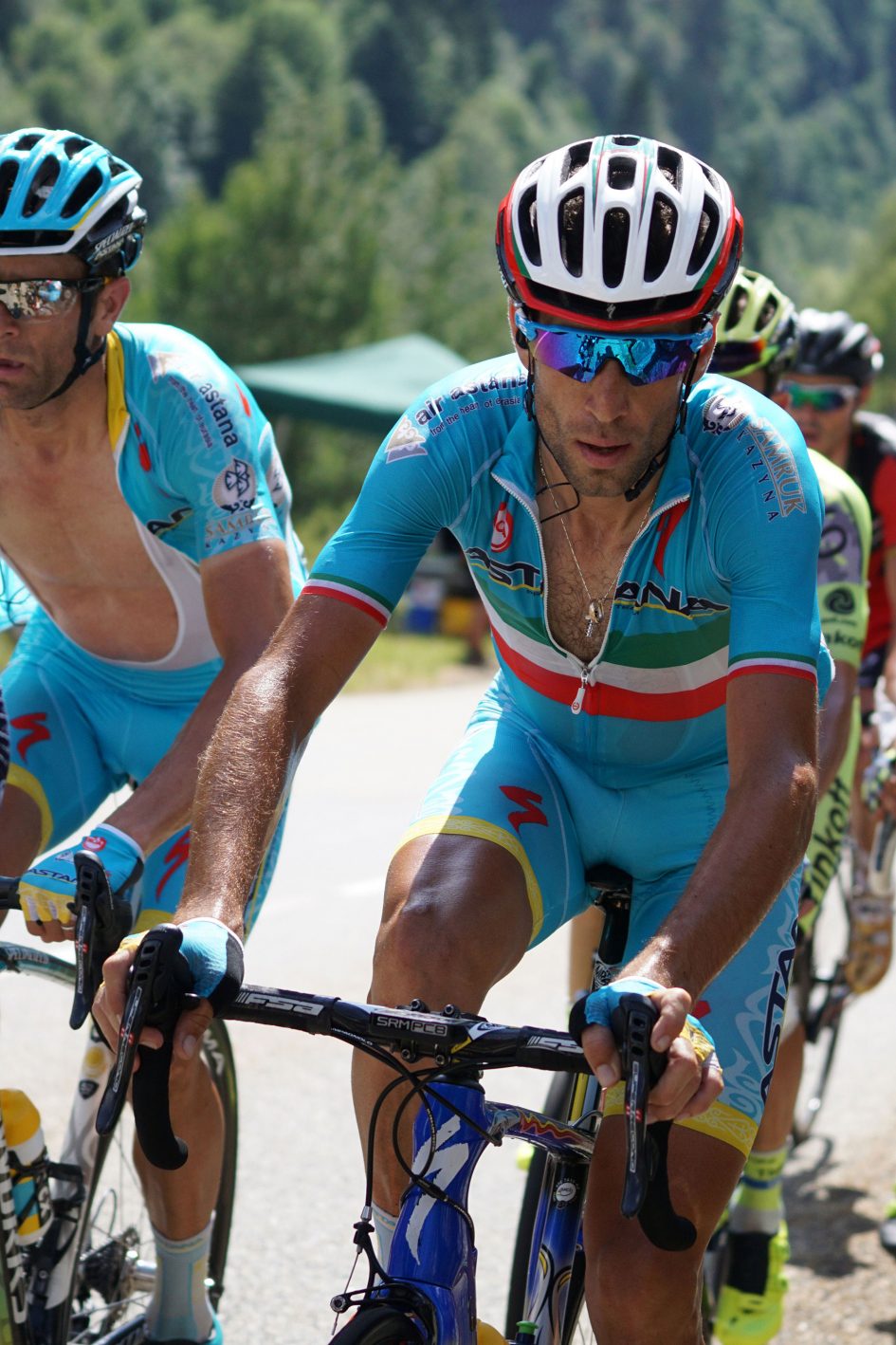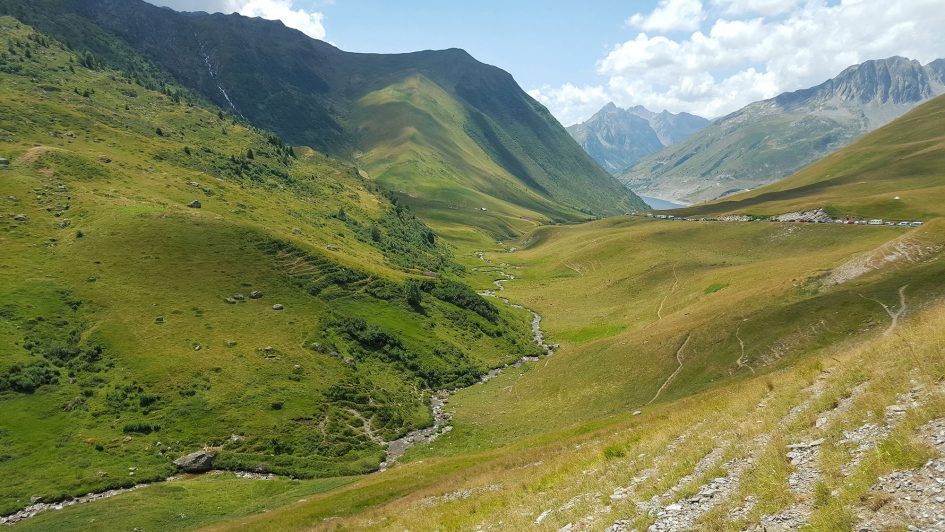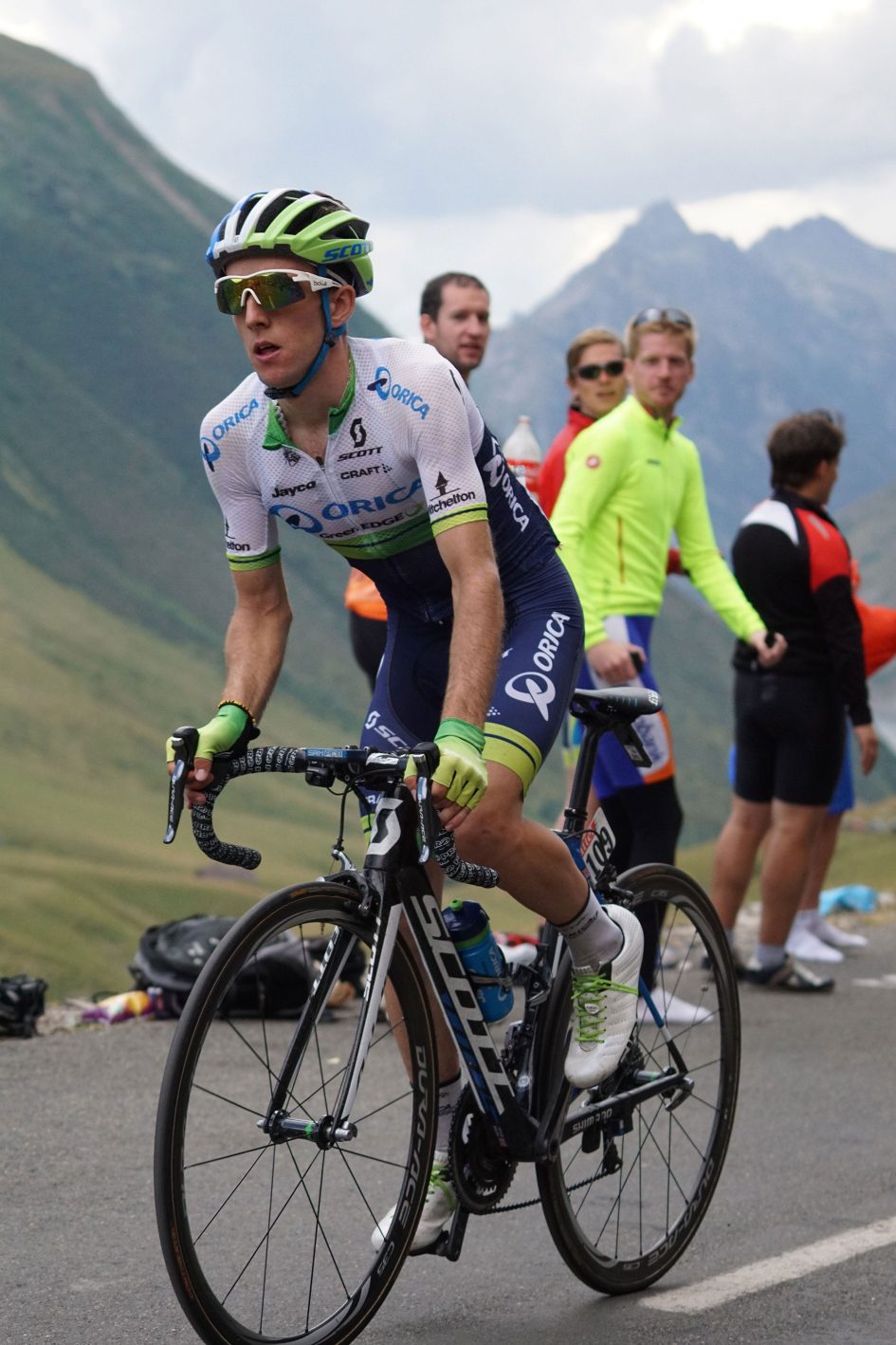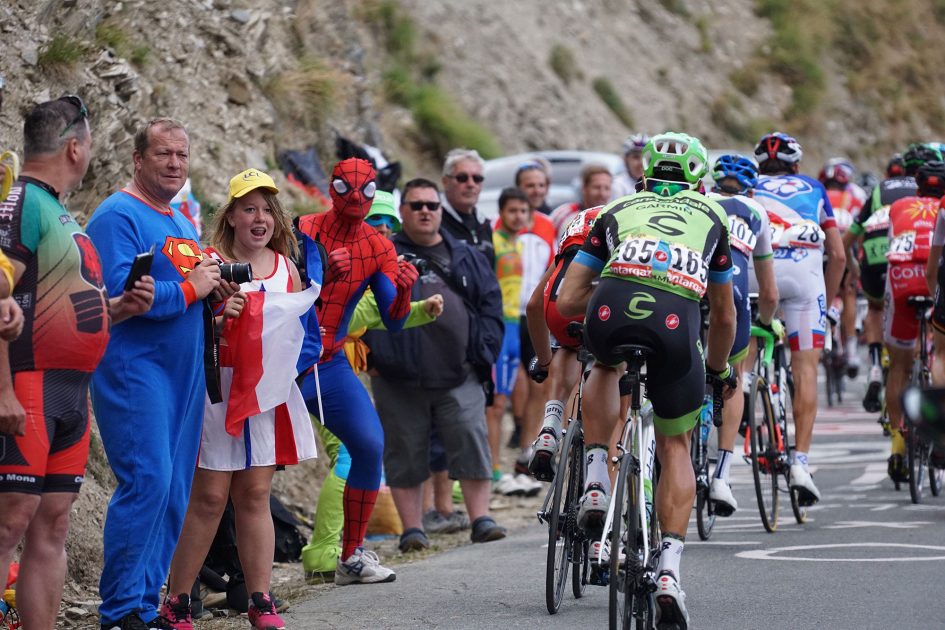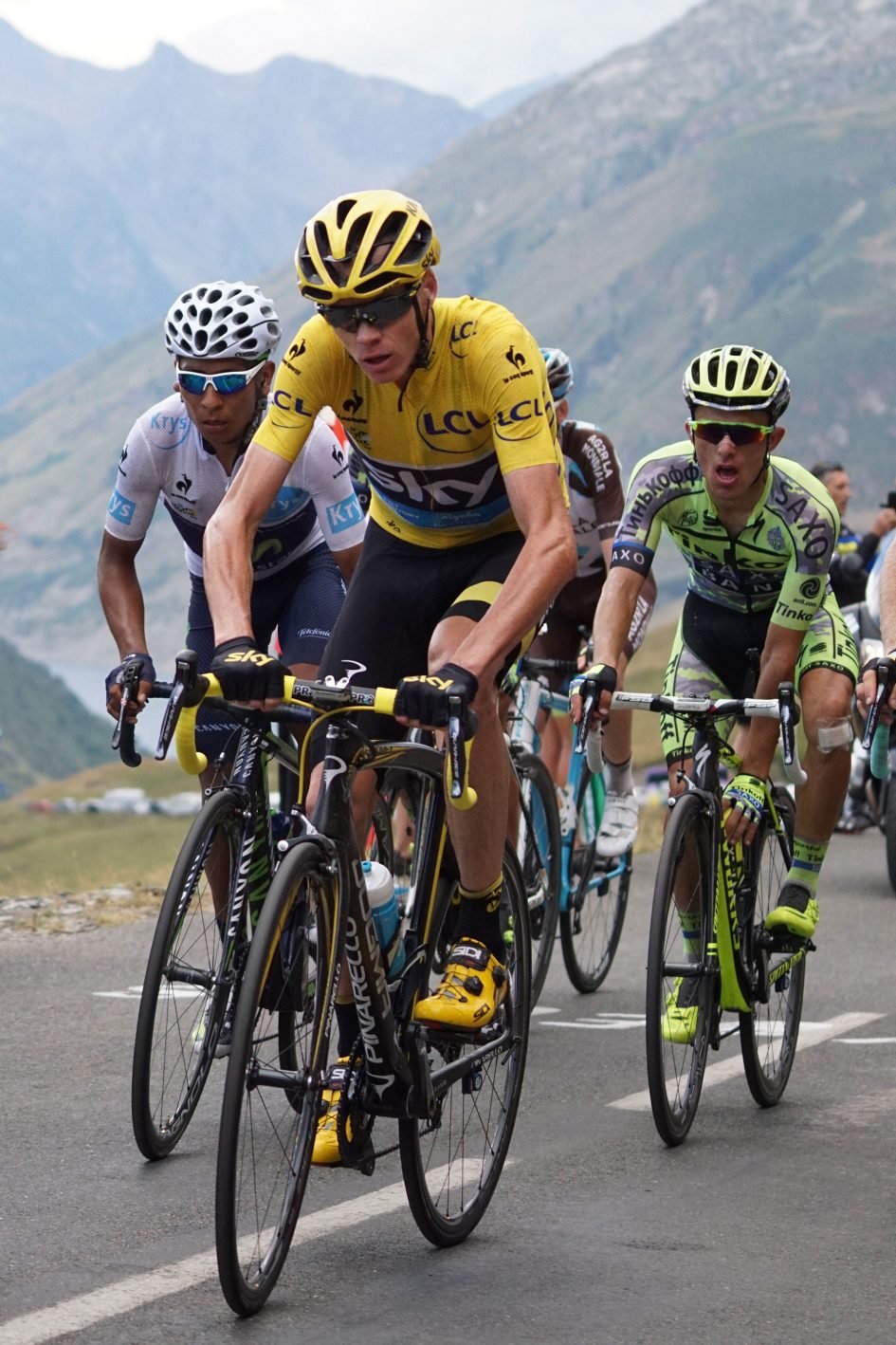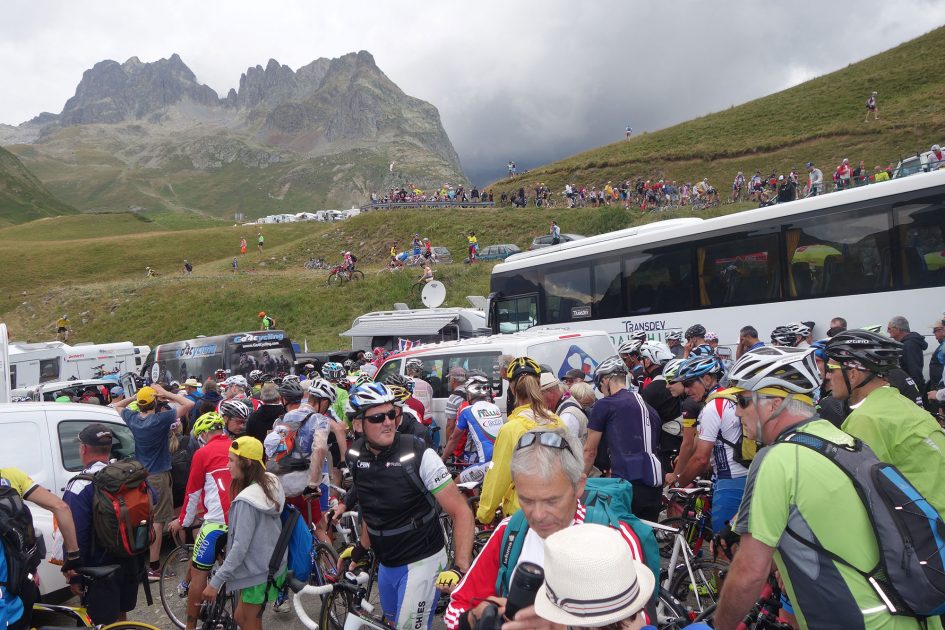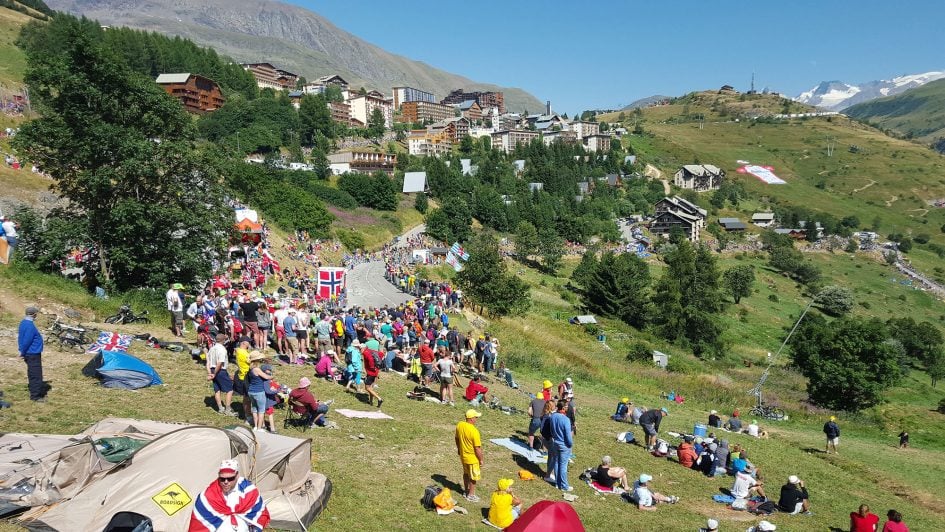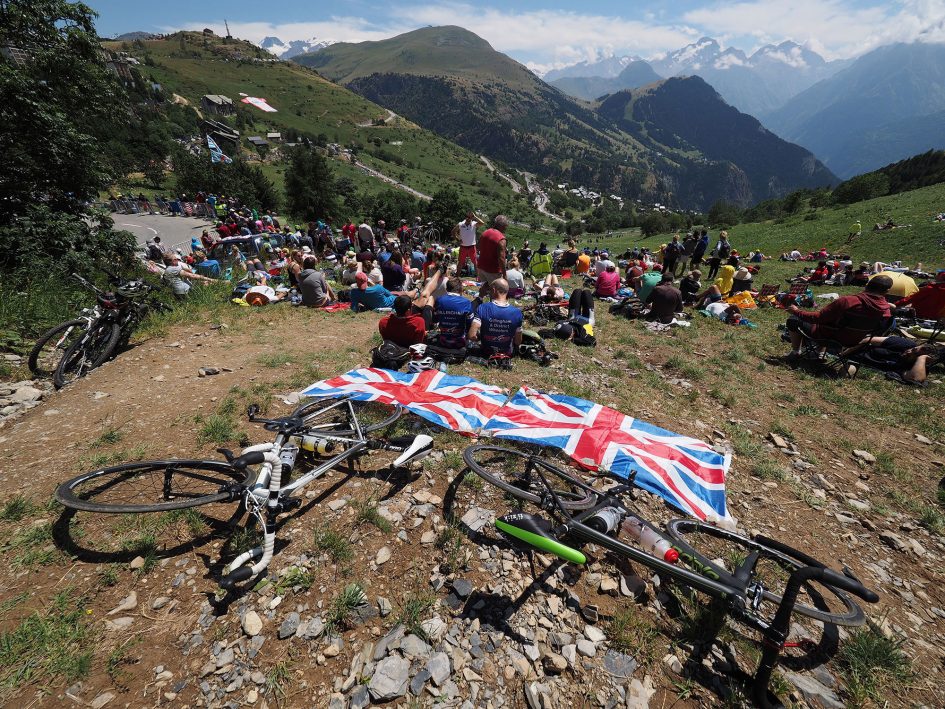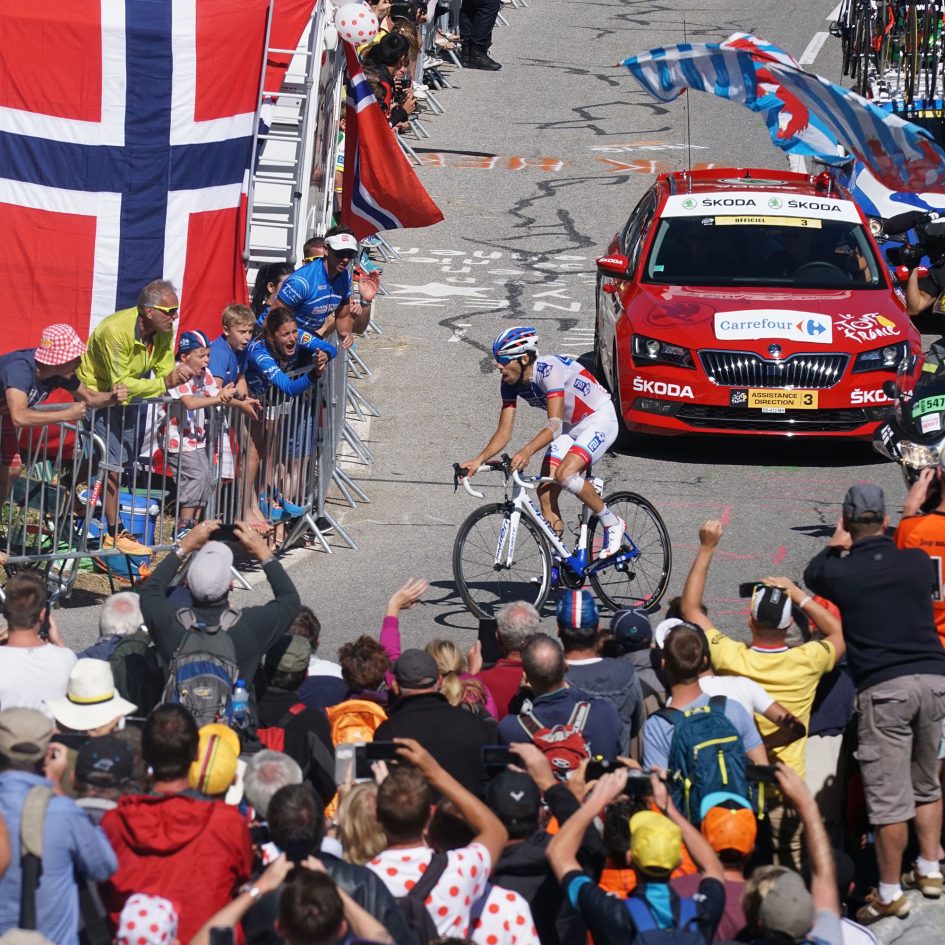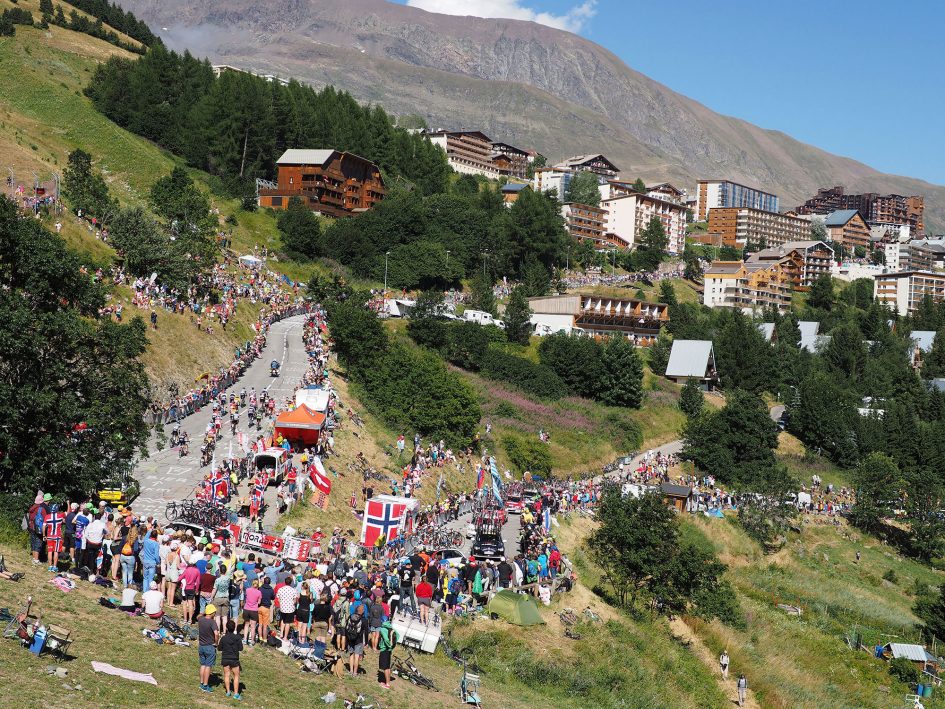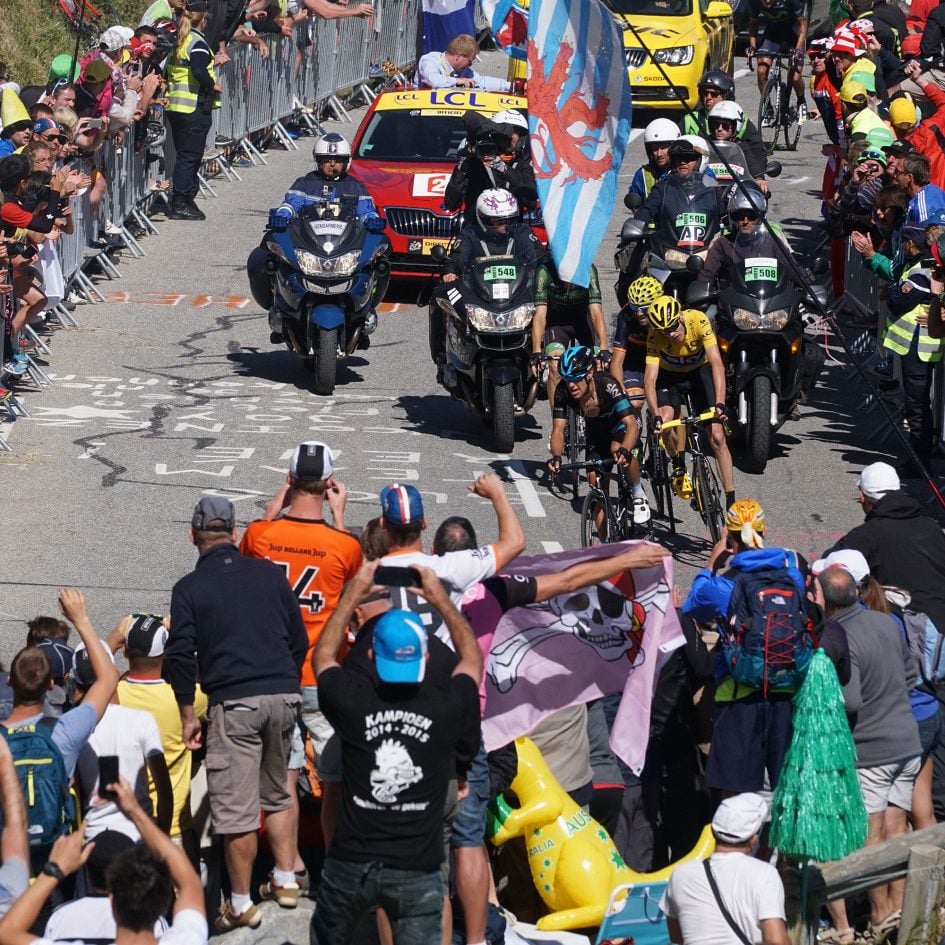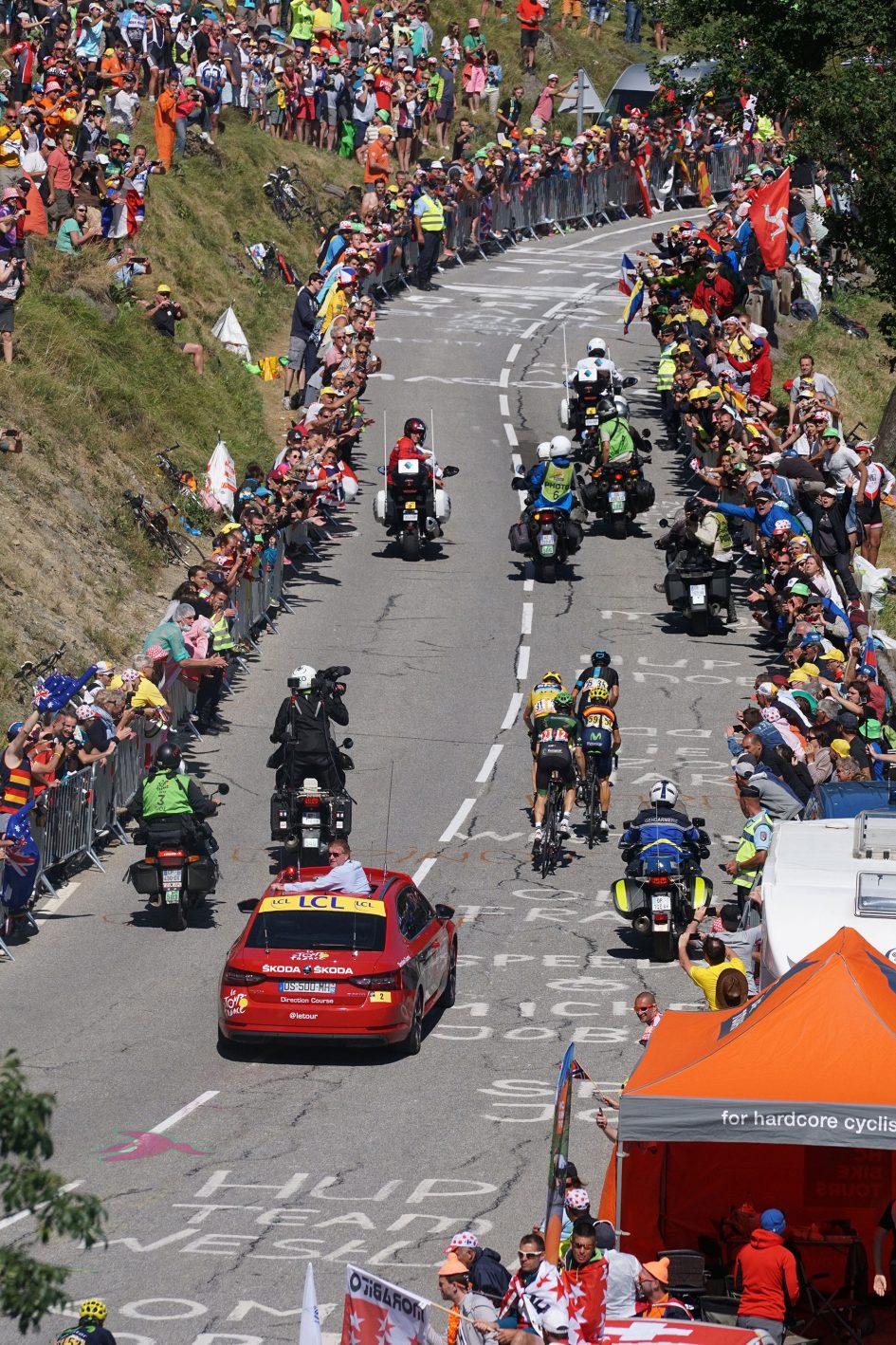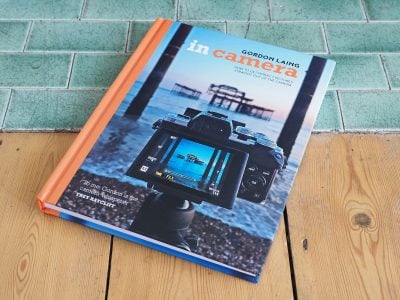How to photograph the Tour de France
-
-
Written by Gordon Laing
The Tour de France takes place every July, with the exciting mountain stages normally concentrated towards the end of the race. If the stars, or at least the local authorities align, this means the school Summer holidays often starts with a few days to race down to Southern France and catch a few of the final climbs in either the Pyrenees or the Alps.
For the 2015 Tour, the final four mountain stages took place in the Alps and I managed to drive our family down in time to catch them. One of the many wonderful things about the Tour de France, not to mention other great bike road races, is the absence of tickets or bookings: you simply turn up at the side of the road and take in the spectacle as the World’s best racers fly by literally a few feet away.
I prefer the mountain stages not just because you really see the riders working as hard as they can, but because it actually slows their pace sufficiently for a good look or photo opportunity. Normally the hills also stretch out the riders into several bunches, giving you multiple opportunities to view, shoot and adapt your technique. Even better if you’re on one of the hairpin bends where they slow down further.
The gear
For the 2014 Tour de France I was delighted to discover an affordable mirrorless camera was up to the task of capturing fast action with a high degree of success: namely the Sony A6000. One year on and there’s still nothing to beat it for the money if you’re into shooting sports. It boasts the killer combination of effective continuous AF across the entire frame (not just in a concentrated diamond in the middle) and fast 11fps burst shooting. I find I can normally achieve at least seven or eight frames per second that are in sharp focus, which gives me loads to choose from for the decisive moment.
The high 24 Megapixel resolution of the A6000 also gives you plenty of latitude for cropping if necessary, but I found the great AF coupled with close access to the riders meant they often filled the frame with no cropping necessary.
One of the best lenses to go with the A6000 for sports shooting is the Sony FE 70-200mm f4G OSS. Sure, the f4 focal ratio means you won’t enjoy a massive degree of separation in terms of depth of field, but it does mean the lens is smaller, lighter and cheaper than an f2.8 version. Together with the A6000 it makes a surprisingly compact and light combination.
For more details, see my Sony A6000 review and Sony FE 70-200mm f4 review.
The settings
For the 2014 Tour I generally used a single AF area and attempted to position it over the rider’s face as they approached. This allowed me to target specific riders in a busy pack, but proved challenging to maintain as they approached and adjusted their lines at speed.
So for the 2015 Tour I decided to try out the Zone AF, which automatically selects an AF area within a concentrated region. It prioritises the closest subject in that region, so it sometimes gets confused and focuses on the road in front when the subject is distant, but as the subject becomes closer and more dominant in the frame, the scattering of AF areas generally locks-on successfully, and while it may select the handlebars as opposed to the rider’s face, the depth of field at f4 is normally sufficiently forgiving to nail the shot.
In terms of exposure, I like to use a shutter speed of 1/2000 as a minimum to freeze the action at 200mm, and again I like to keep the aperture wide-open at f4 to minimize the depth of field. Previously I’d shoot in Aperture Priority and select an ISO value that would deliver the desired shutter speed or thereabouts. But varying light conditions throughout the day meant I was often changing ISO when I needed to concentrate on the action. The obvious solution is to shoot in Manual exposure mode to fix the aperture and shutter at the desired values, and let the camera work out the sensitivity with Auto ISO. I also added +0.3EV compensation as the reflective surface of the road often causes the metering to under-expose on bright days.
These techniques worked well on the four stages I shot in the mountains, so long as I didn’t mind waiting for the riders to become large enough on the frame for the Zone AF system to lock-onto the one in the front. As the Sun dipped in and out of clouds, the A6000 automatically varied the sensitivity between around 200 and 1000 ISO to maintain the desired exposure.
As for Zone AF, I found it effective when individual riders were close, but when I was looking for a more distant view, taking in the surroundings, I found a single AF area was the best way to ensure the camera knew what I wanted in focus.
Tour de France 2014 Stage 17: Digne-les-Bains to Pra Loup Station
For Stage 17 we stayed in a ski resort halfway up the Col d’Allos, with the route passing through the town and literally past the accommodation towards the end of the stage. While we could have viewed it from the hotel or a roadside café, we decided to head further up the mountain towards the peak. The road was closed at 6pm the night before, but the peak was only a few km up a twisting route from the hotel, making the various hairpins easily accessible by foot. Even better, the resort had one of the chairlifts working, so for a few Euros we rode halfway up the remaining mountain and wandered only a few hundred yards to a good spot by the side of the road to set up camp.
We always travel with several small blankets and sheets which we can cobble together into a simple teepee using my tripod and a variety of stones. This provides some basic shelter from the Sun and is also a good focal point for the Caravan as it passes by prior to the race, scattering little gifts for the kids.
We also take plenty of water, food for lunch and a campstove, hand-grinder and Aeropress to make a decent coffee as we await the action. Typically you’ll need to arrive four to six hours prior to the race passing by on a popular mountain stage to bag a decent view, so it’s important to bring everything you need to keep you – and any kids – entertained, fed and watered.
The long and relentless climb up to the Col d’Allos split the riders into multiple groups, giving me lots of chances to shoot and refine my technique. Early on came two of my favourite riders, Peter Sagan (in green) and Richie Porte (in black).
Above: Sony A6000 with FE 70-200mm at 200mm f4, 1/2000, 250 ISO
Above: Sony A6000 with FE 70-200mm at 200mm f4, 1/2000, 250 ISO
These are uncropped frames straight from the camera at 200mm f4, and are sharp when viewed at 100%. The background isn’t as blurred as I’d like, but that’s the nature of an f4 lens, and I was lucky not to have the usual array of support vehicles and other riders behind them.
A short while later, the main group of the General Classification leaders rode by, containing Chris Froome, Vincenzo Nibali and Nairo Quintana. Their group was tightly surrounded by police and camera bikes, preventing me from even seeing them until they were literally a few meters away. I managed to fire-off a handful of quick frames and thanks to the AF on the camera, managed to capture most of the GC contenders.
I’ve cropped the image to concentrate on the main riders. The four faces you can see from left to right below are Geraint Thomas (helping Chris Froome), Vincenzo Nibali (the 2014 winner), Chris Froome (the leader in yellow), and Nairo Quintana (in white). Immediately behind Quintana ins a Tinko Saxof rider, who I presume was Alberto Contador and between Nibali and Froome in the yellow helmet is a Movistar rider, who may be Alesandro Valverde. It’s not the most exciting or dynamic shots, but in terms of capturing the 2015 GC contenders, I’ve got them all here.
Above: Sony A6000 with FE 70-200mm at 200mm f4, 1/2000, 320 ISO
After the stage and race leaders had passed by, I aimed for some close-ups and group shots. Here’s one of my favourite ‘portraits’ below showing Lotto rider Thomas de Gendt gritting his teeth as he rode by; again at 200mm f4 and 1/2000, with the camera selecting 500 ISO. This frame is uncropped width-ways with only a little taken from the top to position the riders more attractively.
Above: Sony A6000 with FE 70-200mm at 200mm f4, 1/2000, 500 ISO
My final shot from Stage 17 is a view of one of the bunches. Often large numbers of riders race together in a group known as the Peloton. While Stage 17 effectively split the race into several smaller pelotons, there was still a good chance to capture the road looking filled with riders. I knew the 70-200mm when zoomed-in would deliver a nice compressed perspective, so that’s what I’ve gone for here. I liked many of the shots in this sequence, but have selected one where the riders really do fill the frame, showing how busy it can get. You’re looking at the full width of the frame here, but I’ve sliced a little from the top to keep it nice and tight.
Above: Sony A6000 with FE 70-200mm at 200mm f4, 1/2000, 800 ISO
Tour de France 2014 Stage 18: Gap to Saint Jean de Maurienne
After Stage 17 we drove for five hours around dark and stormy mountain roads to reach our accommodation in the ski resort of Oz en Oisans for about midnight. We picked this for its easy accessibility by cable car to Alpes d’Huez on our last day at the Tour, but it would also be fairly close to Stages 18 and 19. So four nights booked and a rare chance to unpack more of the car than normal.
I should also note I recharged my A6000 on the way home with it connected to a cigarette lighter / USB adapter in my car. I love being able to recharge my gear before I even reach home.
The (literal) high-point of Stage 18 was the long climb up the Col du Glandon which was only about an hour’s drive from our accommodation on Oz Oisans. The only problem was the road up to Col would be closed from 10am to 6pm, so on a morning when I really could have done with a lie-in, we were up and aiming for the mountain. We made it just about ten minutes before the road was closed, allowing a final bunch of cars to drive up and down trying to find somewhere suitable by the side of the road to park.
As always, the campervans had arrived the night before – or in some cases earlier still – and had bagged the best laybys, but there’s still always plenty of opportunities to squeeze your car in somewhere. We found a good spot up a long straight climb with a small area to pitch our makeshift shelter. With the race not due to pass until about 4pm, we had a wait of roughly six hours, but at least with the shelter of the car and of course access to anything we want from the boot.
That’s the balance you have to weigh-up when choosing how to view a stage on the Tour. If you arrive early enough you could park your car on the actual route, but you will be there for a long time, maybe even from the night before. If you arrive on foot – or by bike – you can leave it to the last minute if you like, but of course it’s harder work and you’ll be limited in what you can carry.
We end up doing a combination of both and for the 2015 Tour would have two days with the car and two on foot. I actually wrote the first 2000 words of this article while sat in my car waiting for Stage 18 to pass by – just a shame the rural location meant no coverage on our phones. That’s one of the benefits of viewing the Tour near a ski resort as there’s normally some mobile coverage, even with thousands of people lining the road.
Here’s Movistar rider, Jonathan Castroviejo, enjoying a refreshing drink on the hot climb up the Col du Glandon. As before I used my Sony A6000 and FE 70-200mm f4G OSS set to 1/2000 and f4 in Manual with Auto ISO selecting 250 ISO. He was quite distant at this point, so I’ve cropped the image for a closer look; the benefit of having 24 Megapixels is plenty of latitude for cropping.
Above: Sony A6000 with FE 70-200mm at 200mm, f4, 1/2000, 250 ISO
Here’s another shot from the same location, this time of BMC rider, Damiano Caruso, gritting his teeth as he climbs the mountain road. I started this sequence at 200mm, but as he approached, steadily zoomed-out. This one was at 70mm as he passed right by me.
Above: Sony A6000 with FE 70-200mm at 70mm f4, 1/2000, 400 ISO
As I’ve previously mentioned, the FE 70-200mm f4G OSS doesn’t have a very shallow depth of field, so to maximise the effect (or rather to minimise the depth of field), I try and keep the background as far behind the subject as possible. For cycling that means shooting down a long straight section, so for Stage 18 I found a good spot where I reckoned the riders would be approaching head-on with lots of road behind them. This had me pressed against a section of rock with nowhere to duck back, but I did find a large-ish crack I could lean into should any of the riders get too close!
And they did. As the group of General Classification riders started cycling up the slope towards me, I could quickly see they were going to get very close indeed. I snapped-off a few shots of them at a distance before literally assuming a spread-eagled pose against the rock face as they drew closer. Not wanting to be the guy who caused a collision with his camera, I took it from my eye and also held it against the rock face to keep it out of their way. As luck would have it, this meant it was still pointing approximately down towards the approaching riders, so I fired-off a bunch more photos as they zoomed past. Most ended up being of feet or sky (the actual sky, not Team Sky), but I did grab this one of last year’s TDF winner, Vincenzo Nibali, who I suspect is giving me a slightly dirty look. Don’t worry Vincenzo, you’re not going to fall because of me. I’m a keen, but always responsible spectator.
Above: Sony A6000 with FE 70-200mm at 70mm f4, 1/2000, 400 ISO
Tour de France 2014 Stage 19: Saint-Jean-de-Maurienne to La Toussuire
Towards the end of Stage 19, the tour climbed a different side of the Col du Glandon on the D927 before continuing up the Col de la Croix de Fer on the D926. Our plan was to intercept the route just beyond the top of the Col du Glandon where the D526 met it. The parking opportunities were limited on the Col de la Croix de Fer and occupied by campervans from days before, plus the route itself was closed to vehicles from early in the morning. The D526 was also scheduled to be closed from 10am, so once again it was a case of getting onto it before 10 and driving as far as we could before being stopped by the inevitable roadblock.
Coincidentally the D526 was the same road where we viewed the previous stage, so the road at least was familiar; indeed the intersection with the D926 / D927 was only a short climb beyond our location the day before. As before the road was packed with recreational cyclists, some out to view the Tour, others simply enjoying a riding holiday. Either way, you have to keep your wits about you, driving along winding mountain roads with countless bikes on either side of you.
We knew at some point we’d need to park up before the intersection and walk to a viewing location on the route itself, and as we drove ever closer, we passed many campervans, cars and tents which looked like they’d simply stayed in the same place as the day before. In the end we actually managed to squeeze the car into a ditch about ten minutes walk from the intersection, so with our bags packed with cameras, coffee and a campstove we hiked up.
As before, it’s worth wandering up and down the route a little to find an ideal spot to view the Tour as it races past. Initially I was tempted by the switchbacks of the Col du Glandon, but with the more dramatic landscape of Alpe d’Huez beckoning the day after, I decided to opt for another close encounter as the riders climbed Col de la Croix de Fer.
While my first two stages of the Tour de France this year were in the heart of the Alps, and both in steep climbing sections, I had been slightly bothered that I’d not managed to include much of the surroundings in any of my photos. Sure the A6000 had done a great job at capturing close-ups of the riders, but there was little context as to where they were. A shame since the scenery was so beautiful.
Above: Samsung Galaxy S6, Auto
What really struck me when walking up the D926 on Stage 19 though was the lovely view of the mountains and lake beyond the road. This would be an ideal scenic backdrop to the riders, so I nestled into a cliff wall on the opposite side and waited for them to come past. This time I zoomed the FE 70-200mm out to 70mm for a 105mm equivalent field of view. Not exactly wide-angle, but it allowed me to capture much more of the surroundings.
In this first shot, British rider Simon Yates of Orica Greenedge zips past, and I’m really happy with the way the shot also includes the scenic backdrop along with some fans cheering him on. It’s an uncropped image straight out of the Sony A6000, set to 1/2500 and 70mm f4, with Auto ISO selecting 1000 ISO.
Above: Sony A6000 with FE 70-200mm at 70mm f4, 1/2500, 1000 ISO
As well as wanting to capture more of the scenic backgrounds at the Tour de France I also wanted to capture some the background of the actual race itself, namely the fans and the general spectacle. I knew I’d get some big crowd shots at Alpe d’Huez during Stage 20 the next day, but there were still some particularly colourful characters cheering the riders on around where I was stood for Stage 19. Opposite me were two Canadians, one dressed as a Mountie with an enormous Maple flag and the other wearing a large gorilla head. Then slightly up the road from were a selection of Superheroes including Spiderman, Superman and a Ninja Turtle, accompanied by a cheerleader and some bat-kids.
Having watched numerous mountain stages on TV, I knew straightaway that these were all prime candidates for running alongside the riders, possibly spoiling any shots, or then again potentially enhancing them. Initially I wasn’t happy with their proximity, but in the end, the riders came up this section of the road so fast we were all taken by surprise and not a single person ran after them or caused trouble.
But I still wanted to capture some of the fans, so as a large bunch of riders approached, I turned around and framed-up a shot with the superheroes cheering-on their favourites. This also illustrates how close the spectators get to the riders during most of the race. Spiderman and cheerleader are getting into it, but Superman and Ninja Turtle are strangely subdued.
Above: Sony A6000 with FE 70-200mm at 200mm f4, 1/2500, 1000 ISO
As each bunch of riders cycled past, I fired a burst while panning to follow them. The intention wasn’t to blur the background with motion, but to maximize my chance of capturing a rider with a nice view of the mountains behind them.
Being quite close to a corner, I didn’t have much time to identify each rider before they had actually sailed past, but there was no mistaking the group of General Classification contenders with Chris Froome in the yellow jersey, surrounded by the ever-present Nairo Quintana and Alberto Contador. Vincenzo Nibali had actually rode past a little earlier to eventually win the stage, although I believe Froome had suffered from some mechanical issues just prior to riding past us.
Either way, this is probably my favourite photo of the four stages I attended. Not only does it feature an uninterrupted view of the winner of the 2015 Tour de France alongside his rivals with no motorbikes in the way, but with the lovely scenery of the French Alps in the background. It also illustrates just how close you can get to the cyclists as a spectator.
Above: Sony A6000 with FE 70-200mm at 70mm f4, 1/2500, 1000 ISO
Just one final photo from Stage 19: the journey home! We may all wait for hours for the Tour to pass by, but the moment the last rider has gone, everyone packs up and leaves. This means thousands of people on foot or bikes and in cars or campervans all attempt to get off a mountain at the same time. Chaos ensues, but amazingly I’ve never seen anyone get hurt. I normally just return to my car and wait half an hour or so for it to quieten down.
Above: Sony RX100 II, Auto
Tour de France 2014 Stage 20: Modane Valfrejus to Alpe d’Huez
The final stage in the Alps, and my last of the 2015 Tour, culminated with a climb of the legendary Alpe d’Huez with its multiple switchbacks. It’s such a popular climb that the road is closed to vehicles several days in advance, so if you want to drive up and find somewhere to park on one of the side roads (not on the route itself), you have to commit to it early.
Some people prefer to park in the village at the base and walk or ride up the mountain. An alternative revealed to me by photographer Greg Annandale was the opposite: start at the top of Alp d’Huez and work your way down to a viewing location. But how do you get to the top of a mountain if the road up to it is closed and you don’t have access to a helicopter? The answer is by cable car from the Oz en Oisans resort on an adjacent mountain. Two cable cars will take you from one resort to the other, dropping you off conveniently only a few hundred yards from the finish line at Alp d’Huez.
We’d actually done this two years earlier for the 100th Anniversary of the Tour when both mountains were jam-packed. This time though it was much quieter: we walked straight onto a cable car at about 12-noon, and even on the way back after the race had to wait no more then 15 minutes. Oz en Oisans is really geared-up for this transfer, with loads of parking in the resort, spilling out onto the mountain road itself. So to access a stage on Alp d’Huez, you could stay in Oz, as we did this year, or simply drive up to the resort as we did two years earlier. It’s such an easy way to directly access the heart of an incredibly busy event.
Once you’re on Alp d’Huez, you can walk down the final few km of the course to find a good viewing location. There were plenty of good spots along the road in 2015 even as late as 1pm, but like the final section of all stages, there were barriers preventing you from getting too close. Since I’d already got up close and personal on the previous stages, I decided to go for the spectacle at Alp d’Huez and view the switchbacks from the side of one of the overlooking hills. To access this hill, you should avoid the town and route itself and take a back road to the right side as you exit the second cable car from Oz en Oisans; a short hike along a road and down a ski run and you’ll enjoy expansive views of the winding road and mountains beyond. There’ll be loads of people there, but you’ll easily find plenty of room to sit and enjoy the event as it unfolds.
Above: Samsung Galaxy S6, Auto
There’s also lots of great opportunities to photograph the various fans awaiting the action.
Above: Olympus OMD EM1 with 7-14mm at 7mm f5.6, 1/1250, 200 ISO
From my location I could shoot wide views of the road, or a tighter view of the action. Here’s the first rider up the mountain on the day, Thibaut Pinot, who ended up winning the stage shortly afterwards.
Above: Sony A6000 with FE 70-200mm at 200mm f8, 1/2000, 400 ISO
As the riders went past in various groups, I shot from every focal length in my bag from 14mm to 300mm equivalent. Here’s how the race looks at 50mm equivalent with my Olympus OMD EM1.
Above: Olympus OMD EM1 with 25mm at f4, 1/2000, 200 ISO
My final shot is of course of the 2015 winner, Chris Froome, being lead here up the Alpe d’Huez by team-mate Richie Porte. The GC riders are almost always accompanied by a plethora or police bikes and photographers, making it hard to grab a clear view, and by the time the motorbikes in front had turned the corner, the riders were already becoming obscured by the fans in the front. But I don’t mind as I already had plenty of close-ups. I wanted to show the crowds here and it’s pretty clear from the wide and tight views just how many of them pack the mountain climbs.
Here’s another view of them moments later climbing the next section of the route.
Above: Sony A6000 with FE 70-200mm at 200mm f8, 1/2000, 400 ISO
Conclusion
This was the third year I photographed the Tour de France with a consumer mirrorless camera, and the second with the Sony A6000. Now, the Sony isn’t perfect by any means. I find its screen relatively small and dim, the viewfinder lacks the resolution and size of the latest models, I dislike the convoluted repositioning of single AF areas, and I’m personally not fond of the control ergonomics. But as I mentioned at the start, the A6000 boasts the killer combination of fast burst shooting and effective continuous AF which allows you to shoot sports and action in daylight conditions, even of professional athletes. A year may have past since I last selected it for the Tour, and there’s still nothing to beat it for the money.
Interestingly I chatted to a photographer on one of the stages who was using a Nikon D4s. Now that’s a serious pro sports DSLR, with a big full-frame sensor, 11fps and a high-end AF system. In very spontaneous situations the D4s locked-onto targets much faster than my A6000 and the metering with or without external flash was immaculate; this really comes into its own in lower light or for indoor events where the Sony struggles. He was also able to dial the sensitivity up to 6400 ISO and beyond without any perceptible noise, and physically if we dropped both bodies mine was likely to smash whereas his was more likely to dent the road and live to tell the tale. The D4s is considerably tougher and more confident, especially in low light.
And yet both bodies shot JPEGs at the same speed and while his pixels were much fatter and cleaner, I had 50% more per frame, allowing more cropping. Perhaps most revealingly he’d also left some of his bigger lenses at home as the total combination was too heavy when hiking or riding, whereas my A6000 even with the 70-200mm was comparatively feather-light. Oh, and there’s the small factor of price with the D4s costing roughly ten times as much as an A6000.
Now I’m not going to suggest the A6000 is anywhere near as good as the D4s: one is a consumer camera and the other a professional workhorse. But the fact remains the A6000 shot as fast and given a sufficiently predictable target in daylight conditions, could keep it in focus too. For me as someone who backpacks around, the size and weight are the real killer aspects of the Sony and I caught him looking enviously at times. As much as I love shooting sports with a high-end camera, I know which one I’d be happiest carrying to an event like this.
I also think it’s important that we’re even having this discussion. Of course the A6000 is in a different class to the D4s, but as my photos here have hopefully demonstrated, a consumer mirrorless camera can come home with some surprisingly respectable results. Vive le Tour. Vive mirrorless!
Check prices at Amazon, B&H, Adorama, eBay or Wex. Alternatively get yourself a copy of my In Camera book, an official Cameralabs T-shirt or mug, or treat me to a coffee! Thanks!